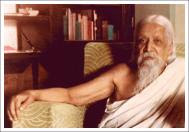 Born on 26 February 1908, Lila Majumdar grew up in Shillong and Kolkata and went on to do a Master’s in English from Calcutta University. She has won many awards for her works, including the Sangeet Natak Akademi Award in 1963 for a comic musical drama called Bok Badh Pala (Death of the Demon Bok). Her autobiography Aar Kono Khaney (Somewhere Else) won the Rabindra Puroshkar in1968, and Haldey Pakhir Palok (The Yellow Bird) received the Bengal state award for children’s literature in 1960. She celebrated her ninety-ninth birthday in 2007 and died the same year on 5 April.
Born on 26 February 1908, Lila Majumdar grew up in Shillong and Kolkata and went on to do a Master’s in English from Calcutta University. She has won many awards for her works, including the Sangeet Natak Akademi Award in 1963 for a comic musical drama called Bok Badh Pala (Death of the Demon Bok). Her autobiography Aar Kono Khaney (Somewhere Else) won the Rabindra Puroshkar in1968, and Haldey Pakhir Palok (The Yellow Bird) received the Bengal state award for children’s literature in 1960. She celebrated her ninety-ninth birthday in 2007 and died the same year on 5 April.To know more about her writings click on link:
LEELA MAJUMDER RACHANA SAMAGRA-01
 IN THIS BOOK LEELA MAJUMDER WROTE SEVERAL
IN THIS BOOK LEELA MAJUMDER WROTE SEVERALSTORIES THAT INCLUDE:
LAKKHI CHELE IN Page-25, BADDINATHER BARI IN Page-
29, BHOTER CHELE IN Page-32, GHONSAR CHITI IN Page-35
ACHAR IN Page-37, DINE DUPUREY IN Page-40, KABLA
KANTA IN Page-43, APOD IN Page-45, CHOR DHORA IN
Page-49, NOTOBORER KARSAGI IN Page-52, GUPEY IN
Page-55,DINE DUPURN PEY IN Page-59, GHOTON KOTHAI
IN Page-61,SORBONESHE MADULI IN Page-67, TAKA
CHURIR KHELA IN Page-72, HUSHARI IN Page-77
MOHALYAR UPOHAR IN Page-81,PADIPISHIR BARMI BAXO IN Page-85, KHAGAI NAMO
IN Page-117, SEKALE IN Page-121, TIGER IN Page-124, CHOR IN Page-129, LOM HORSHK
IN Page-131, GUPER BAHADURI IN Page-133,PALOHAN IN Page -136, AMADER DESHE
IN Page-139, NOTE MAMA IN Page-141,HARANO GINISH IN Page-145,GUPTA DHON IN
Page-147, DAMUKAKAR BIPATTI IN Page-149,VALOBASHA IN Page-152,PASHER BARI
IN Page-155, BHANUMATIR KHEL IN Page-158,HARI NARAYAN IN Page-161,HALDEY
PAKHIR PALOK IN Page-165,GUPIR GUPTO KHATA IN Page-207,BAGHER CHOK IN Page-
255,PENETI TE IN Page-257,AHIRITOLAR BARI IN Page-261,VHUTUREY GOLPO IN Page-
264,SATTI NOI IN Page-268,BOHURUPI IN Page-271, MEGO MAMAR PRATISODH IN Page-
274, KI BUDHHI IN Page-277, JUGANTOR IN Page-279,PANCH MUKHI SANKH IN Page-282
GUN KORA IN Page-286, DINER SESHEY IN Page-290,BONER DHARE IN Page-294.
BAGER CHOKH IN Page-298,BOKH DHARMIK IN Page-303,SEGO MAMAR CHANDRA
JATRA IN Page-349,PEARA GACHER NICHEY IN Page-356,SEI KHANEY IN Page-358.
AMI IN Page-361, BANDUK O CHORA IN Page-363,TONG-LING IN Page-367,GUNU PANDI
TER GUN PANA IN Page-417,PAKHI IN Page-424,MAJICK IN Page-430,DIAREY IN Page-433
ICHHEY GAI IN Page-436,PORIDER DESHEY IN Page-441,HANA BARI IN Page-444,SAGOR
PAREY-448,BAROLOK HOBAR NIAOM IN Page-451,JADUKAR IN Page-454,ANKO IN Page-
458,NOKOSHI IN Page-464,CHI HUA IN Page-471,ATITHI IN Page-474,NEPOR BOI IN Page-
479,MAKU IN Page-527, BOK BADH PALA IN Page-577, LANKA DAHAN PALA IN Page-599
BALI SUGRIB KATHAN IN Page-623,WAITING ROOM IN Page-635
LEELA MAJUMDER RACHANA SAMAGRA-02
 IN THIS SECOND EDITION OF LEELA MAJUMDER
IN THIS SECOND EDITION OF LEELA MAJUMDERRACHANA SAMAGRA YOU WILL GET:
GUPIR GUPTA KHATA IN Page-9,LANKA DAHAN PALA
IN Page-87, UPENDRAKISHORE IN Page-123, BHOOTER
GOLPO IN Page-187, NANA NIBANDHA IN Page-289
BOK DHARMIK IN Page-365
LEELA MAJUMDER RACHANA SAMAGARA-03
IN THIS BOOK YOU WILL GET TONG LING IN Page-9, SUKUMAR
ROY IN Page-79,NEPOR BOI IN Page-203,SEGO MAMAR
 CHANDA JATRA IN Page-279
CHANDA JATRA IN Page-279 TAKHURMAYER TIKUJI
TAKUMAR TIKUJI IS A COMPARATIVE STUDY OF LIFE BETWEEN FAMOUS
WRITER LEELA MAJUDER AND
HER DIDI SHASURI JOYENTI OR MADDHURIMA OR RIMA BY NAME,
WRITER LEELA MAJUDER SUDDENLY
DISCOVER A NOTE BOOK WRITEN BY HER DIDI SHASHURI AND A
DIAMOND RING OF HER. THE NOTE
BOOK CONTAIN 365 PAGE OF HER DAYA TO DAY LIFE EXPERIENCE
THAT COMPARE WIITH THE WRITER
LEELA MAJUDER OWN LIFE. WRITER ALSO DESCRIBE HER LIFE WHEN SHE WAS IN WOOD STREET
HOUSE.
BATASBARI
GUPIR GUPTA KHATA

RESHALARBABU
LEELA OMIBUS
MOYNA SHALIK
KHEROR KHATA
SUKUMAR
GULLIVER TRAVEL
PODIPISHIR BORMI BAXO
NAKU GAMA
HALDEY PAKHIR PALOK
TOJO








.jpg)























